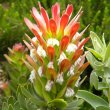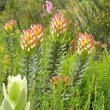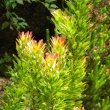| Botanical Name |
|
| Family |
Proteaceae - The Protea family
|
| Pronunciation |
MIM-et-teez kuk-yoo-LAY-tus |
| Common Name(s) |
English: Common Mimetes; Common Pagoda; Red Mimetes; Red Pagoda
Afrikaans: Rooistompie; Stompie
|
| Plant Group |
- Fynbos Certain plants endemic to the areas of the Western Cape of South Africa that have a Mediterranean climate of cold, wet winters and hot, dry summers.
- Shrub A woody plant of relatively low height, having several stems arising from the base and lacking a single trunk; a bush.
|
| Plant Size |
- Medium
| Tree | 10m to 16m |
| Shrub | 1m to 2m |
| Perennial/ground cover | 40cm to 60cm |
| Bulb | 40cm to 60cm |
| Succulent | 40cm to 60cm |
- Small to Medium
| Tree | 8m to 15m |
| Shrub | 75cm to 1m |
| Perennial/ground cover | 20cm to 40cm |
| Bulb | 30cm to 40cm |
| Succulent | 20cm to 40cm |
- Small
| Tree | 4m to 8m |
| Shrub | 50cm to 75cm |
| Perennial/ground cover | 10cm to 20cm |
| Bulb | 20cm to 30cm |
| Succulent | 10cm to 20cm |
|
| Position |
- Sun The area is in full sun for all or most of the day, all year round.
|
| General Information |
- Drought Tolerance: Moderate The plant is moderately adapted to arid conditions and can survive short periods of drought and high temperatures without extra water.
- Evergreen Plants that have leaves all year round.
- Frost: Half-hardy The plant is able to survive low temperatures and some frost but requires protection against severe frost.
- Prune hard after flowering Fast growing shrubs that grow lanky within a season. Cut off branches and stems of these plants to a third of their original length. This will increase the yield of flowers, improve the plants shape and enhance the structural strength of main branches.
- Sand tolerant Plants adapted to survive in nutrient poor, very sandy soils.
- Water Moderate These plants will need some extra watering compared to water-wise plants. Plant them together, in at least some shade and in a convenient proximity to the house so that grey water can be utilised during times of drought.
- Wind Tolerant Plants able to withstand the effect of strong winds.
|
| Specific Information |
Mimetes cucullatus is an unusual and beautiful, multi stemmed, small to medium shrub and is the best known and most widespread of the Mimetes group. It has numerous erect branches which are covered with overlapping, oblong leaves which change from green on the lower parts to yellow and bright red at the top. The leaves are hairless and have a few small red teeth at the tips. This is the only Mimetes to resprout after fire, due to the large underground rootstock it develops as it matures. The upper leaves may vary from red to yellow or greenish-yellow.
According to growers in the U.S.A. the plant is suitable for USDA zones 9 to 11 and tolerates acidic to neutral soils.
|
| Ad Break |
|
| Flowers |
| Description |
flowers are fluffy, presented in tufts of 4 - 7 florets, with up to 15 tufts emerging from the bright red leaves of the upper stem
|
| Season |
- All Year Plants will seldom bloom for the entire season as given in the list, but should flower during a period within these parameters.
- Spring to Autumn Plants will seldom bloom for the entire season as given in the list, but should flower during a period within these parameters.
|
| Colour |
|
| Growth Rate |
- Moderate Specifying growth rate can be very misleading as there is considerable variation of growth rate depending on type and species of plant, available water, supplementary feeding, mulching and general care, as well as the plants suitability and adaptability to the garden environment.
|
| Plant Uses |
- Accent or Focal Point A plant used to attract the attention because of its colour or form.
- Attracts bees, butterflies or other insects This plant attracts insects which can be food for birds or other creatures in your garden.
- Attracts Birds This plant will attract birds.
- Border A strip of ground, at the edge of a driveway or path in which ornamental plants or shrubs are planted.
- Container Trees, shrubs and ornamental species that can adapt to growing in a restricted environment.
- Cut Flowers Plants that provide flowers suitable for ornamental uses.
- Filler Either a fast growing tree or shrub used temporarily to fill in an area while the permanent plants grow to a desired size, or a plant used to fill gaps in borders or beds.
- Rock Garden An area constructed of larger rocks, arranged naturally, to emphasise the use of stones as a main element. Generally plants used do not need a lot of care.
- Suitable for coastal gardens Plants adapted to dry, sandy soil, forceful wind, limited rainfall and intense sunlight.
- Suitable for smaller gardens Such plants do not have invasive root systems, remain small or controllable and can often be grown in containers.
|
| Distribution and Habitat |
in the southern parts of the Western Cape, most frequently on the cool, moist, south-facing slopes and damp flats, from sea level to 1 200 m, in sandy soils
|
| Planting Suggestions |
Plant Mimetes cucullatus in well drained, sandy, acidic to neutral soil, in a sunny, airy position, preferably on a slope. Water well during autumn, winter and spring and moderately during summer. Well rotted compost and a layer of mulch should help to keep the soil moist. An organic, slow-release fertilizer may be used but strong fertilizers and animal manure will burn the roots. As with other members of the Proteacea family, care must be taken not to disturb the surface roots. This plant can be pruned hard after flowering and older plants that show signs of starting to flag, can be cut back to the base, after which it will grow with renewed vigour.
Although easy to grow, Mimetes cucullatus is very difficult to propagate from seed and cuttings must be bottom heated and misted. Unfortunately for the gardener, this means that the plant is seldom, if ever, made available at nurseries.
|
| Medicinal Uses |
In the past, the bark was used for tanning.
|
| Ad Break |
|








Discuss this plant
Share knowledge, ask a question or give an experience.